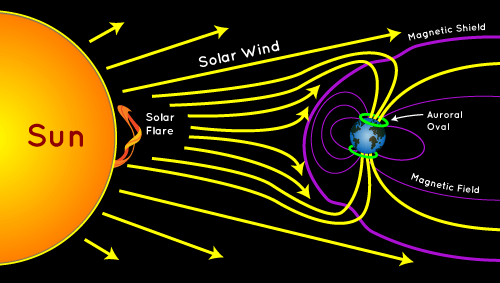Important Facts For Prelims
Auroras, Solar Flares, CMEs & Solar Storms
- 20 Nov 2025
- 7 min read
Why in News?
Recent Solar storms and coronal mass ejections (CMEs) during the heightened Solar Cycle produced colourful lights in the Northern Hemisphere, visible far from the Arctic region.
What are Solar Cycle, Solar Flares, Coronal Mass Ejections (CMEs) and Solar Storms?
- Solar Cycle: The solar cycle is an approximately 11-year cycle of the Sun’s magnetic field, during which its magnetic activity rises and falls. The Sun undergoes a complete magnetic polarity flip every cycle, with its north and south poles switching places.
- This cycle influences solar surface activity, including sunspots (small, dark, and cooler areas on the sun surface), solar flares, and CMEs.
- The cycle is monitored by counting sunspots, starting with a solar minimum when activity is lowest and reaching a solar maximum when solar activity is at its peak.
- Solar Flares: The magnetic field lines around sunspots often become tangled, cross, and realign, triggering powerful bursts of energy called solar flares. These flares release intense radiation into space, and strong flares can disrupt radio communications on Earth as well as pose risks to satellites and astronauts.
- Coronal Mass Ejections (CMEs): Solar flares are often accompanied by CMEs, which are massive expulsions of plasma and magnetic field from the Sun’s outermost layer - corona. CMEs are propelled into space at high speeds when the Sun’s magnetic field lines rapidly reorganize.
- Solar Storms: Solar storms (geomagnetic storms) occur when a large-scale magnetic eruption, often accompanied by a CME and solar flare, accelerates charged particles in the Sun’s atmosphere to high speeds.
- When a CME reaches Earth, it interacts with the magnetosphere, compressing and agitating it, and allowing energetic solar wind particles to enter the atmosphere near the poles.
- The Earth’s magnetosphere, generated by its magnetic fields, normally shields moons from these solar particles.
What are Auroras?
- About: An aurora is a captivating natural light display seen in the night sky, featuring shifting colours like blue, red, yellow, green, and orange. The green-yellow auroras are the most common, caused by ions colliding with oxygen atoms at lower altitudes.
- Formation of Auroras: Auroras occur when charged particles from the Sun, carried by the solar wind, reach Earth.
- Earth’s magnetic field directs these particles toward the poles, where they collide with gases like oxygen and nitrogen in the upper atmosphere.
- These collisions cause the gases to become excited and release light, which forms the colorful displays we see as auroras.
- The specific colors depend on the type of gas and the altitude of the collisions.
- Geographical Spread: Auroras are typically observed near the Arctic and Antarctic Circles (around 66.5° north and south). It is of two types:
- Aurora Borealis: The northern lights, called aurora borealis, occur near the North Pole and are typically visible in Norway, Sweden, Finland, Canada, and Alaska.
- Aurora Australis: The southern lights, called aurora australis, occur near the South Pole and are visible in Antarctica, southern Australia, New Zealand, and Chile.
- Prediction: The Kp-index (Planetary K-index) is a global 0–9 scale measuring disturbances in Earth’s magnetic field from the solar wind, indicating geomagnetic storm strength.
Frequently Asked Questions (FAQs)
1. What is a Solar Cycle?
A solar cycle is an 11-year cycle of the Sun’s magnetic activity, marked by fluctuating sunspots, solar flares, and CMEs, with magnetic poles swapping every cycle.
2. What are Coronal Mass Ejections (CMEs)?
CMEs are massive bursts of charged particles from the Sun, often accompanying solar flares, and can trigger geomagnetic storms on Earth.
3. How do Auroras form?
Auroras form when solar wind ions collide with oxygen and nitrogen in the ionosphere, producing colourful lights near the geomagnetic poles.
4. What are the impacts of Solar Storms on Earth?
Solar storms can affect power grids, satellites, radio communications, and air traffic, while also producing spectacular auroras visible far from the poles.
UPSC Civil Services Examination, Previous Year Question (PYQ)
Prelims
Q. If a major solar storm (solar flare) reaches the Earth, which of the following are the possible effects on the Earth? (2022)
- GPS and navigation systems could fail.
- Tsunamis could occur at equatorial regions.
- Power grids could be damaged.
- Intense auroras could occur over much of the Earth.
- Forest fires could take place over much of the planet.
- Orbits of the satellites could be disturbed.
- Shortwave radio communication of the aircraft flying over polar regions could be interrupted.
Select the correct answer using the code given below:
(a) 1, 2, 4 and 5 only
(b) 2, 3, 5, 6 and 7 only
(c) 1, 3, 4, 6 and 7 only
(d) 1, 2, 3, 4, 5, 6 and 7
Ans: (c)
Q. Electrically charged particles from space travelling at speeds of several hundred km/sec can severely harm living beings if they reach the surface of the Earth. What prevents them from reaching the surface of the Earth? (2012)
(a) The Earth's magnetic field diverts them towards its poles
(b) Ozone layer around the Earth reflects them back to outer space.
(c) Moisture in the upper layers of atmosphere prevents them from reaching the surface of the Earth
(d) None of the statements (a), (b) and (c) given above is correct
Ans: (a)
Mains
Q. What are aurora australis and aurora borealis? How are these triggered? (2024)








